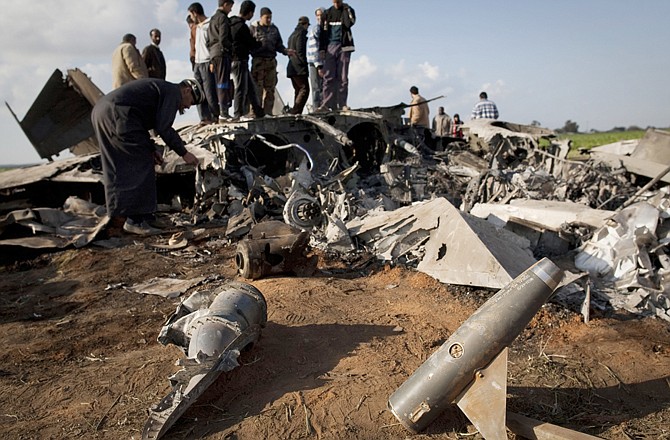The four-day air assault in Libya will soon achieve the objectives of establishing a no-fly zone and averting a massacre of civilians by Moammar Gadhafi's troops, President Barack Obama said Tuesday, adding that despite squabbling among allies, the United States will hand off control of the operation to other countries within days.
"When this transition takes place, it is not going to be our planes that are maintaining the no-fly zone. It is not going to be our ships that are necessarily enforcing the arms embargo. That's precisely what the other nations are going to do," the president said at a news conference in El Salvador as he neared the end of a Latin American trip overshadowed by events in Libya.
Obama said he has "absolutely no doubt" that a non-U.S. command entity can run the operation, although perhaps the most obvious candidate - the NATO military alliance - has yet to sort out a political agreement to do so. The president said NATO was meeting to "work out some of the mechanisms."
Coalition forces pounded Libyan military targets with 24 more Tomahawk missiles, expanding the no-fly zone over the North African nation but suffering the loss of a U.S. fighter jet, U.S. officials said Tuesday.
And the on-scene commander, Navy Adm. Samuel J. Locklear, confirmed that troops of leader Moammar Gadhafi were attacking civilians in the city of Misrata. He said that as the international mission continues, coalition forces will better be able to target government troops.
Two dozen more Tomahawk cruise missiles were launched from U.S. and British submarines, a defense official said earlier in the day. Locklear didn't give details but confirmed that brought to 161 the number of Tomahawk strikes aimed at disabling Libyan command and control facilities, air defenses and other targets since the operation started Saturday.
Locklear said the additional strikes had expanded the area covered by the no-fly zone.
He said intelligence showed that Gadhafi's forces were attacking civilians in Misrata, Libya's third-largest city. In a joint statement to Gadhafi late Friday, the United States, Britain and France called on him to end his troops' advance toward Benghazi and pull them out of the cities of Misrata, Ajdabiya and Zawiya.
Locklear said the coalition is "considering all options" but didn't elaborate. Asked if international forces were stepping up strikes on Gadhafi ground troops, Locklear said that as the "capability of the coalition" grows, it will be able to do more missions aimed at ground troops who are not complying with the UN resolution to protect those seeking Gadhafi's ouster.
The overall commander of international military action, Gen. Carter Ham, said Monday that the operation was achieving its goal of setting up a no-fly zone to protect Libyan civilians from Gadhafi. Building on what Ham called a successful first stage, the focus was shifting to widening the no-fly zone across the North African country while continuing smaller-scale attacks on Libyan air defenses and setting the stage for a humanitarian relief mission.
Pilots safe after crash
The U.S. fighter jet crashed in Libya after an apparent equipment malfunction but both crewmembers were able to eject and were back in American hands with only minor injuries.
The F-15E Strike Eagle jet was conducting a mission Monday night against Libyan air defenses when it crashed at 5:30 p.m. EDT, said Lt. Cmdr. Karin Burzynski, a spokeswoman for the U.S. Africa Command.
A spokesman for the Libyan opposition, Mohammed Ali, said the U.S. plane went down about 25 miles outside of the eastern rebel stronghold of Benghazi, Libya's second-largest city.
One of the jet's airmen landed in a field of sheep after ejecting from the plane, then raised his hands and called out "OK, OK" to a crowd who had gathered, a British newspaper quoted witness Younis Amruni, 27, as saying.
"I hugged him and said: 'Don't be scared, we are your friends,"' Amruni told the newspaper, adding that people then lined up to shake the airman's hand.
"We are so grateful to these men who are protecting the skies," he said. "We gave him juice and then the revolutionary military people took him away."
A Marine Corps Osprey search and rescue aircraft retrieved the main pilot, while the second crew member, a weapon systems officer who is also a pilot, was recovered by rebel forces and is now in American hands, a U.S. official said in Washington.
Amruni said the Osprey fired shots to keep locals away, then swooped in and rescued the second crew member.
The two were separated after ejecting from the crippled jet at high altitude and drifting down to different locations, Africa Command spokesman Vince Crawley said, adding they sustained minor injuries.

